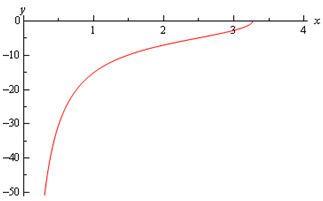Solve the subsequent IVP and find the interval of validity for the solution
xyy' + 4x2 + y2 = 0, y(2) = -7, x > 0
Solution:
Let's first divide on both sides by x2 to rewrite the differential equation as given,
(y/x)y' = -4 - (y2/x2)= - 4 - (y/x)2
Here, it is not in the officially exact form as we have listed above, though we can see that everywhere the variables are listed they put in an appearance as the ratio, y/x and thus this is truly as far as we require to go. Therefore, let's plug the substitution in this form of the differential equation to find,
n (n+ x n') = - 4 - n2
Subsequently, rewrite the differential equation to determine everything separated out.
n x n' = - 4 - 2n2
x n' = - (4 + 2n2)/ n
n/(4 + 2n2) dv = - (1/x) dx
Integrating on both sides we find,
¼ In (4 2n2) = - In (x) + c
We require doing a little rewriting using fundamental logarithm properties in order to be capable to easily solve this for n.
In (4 2n2)¼ = In (x)-1 + c
Then exponentiates on both sides and do a little rewriting,
(4 + 2n2)¼
= eIn(x)-1 + c
= 
= c/x
Remember that as c is an unknown constant so next is ec and so we may also just call this c as we did above.
At last, let's solve for v and after that plug the substitution back in and we'll play a little fast and loose along with constants again.
4 + 2n2 = c4/x4 = c/x4
n2 = ½ ((c/x4)- 4)
y2/x2 = ½ ((c - x4)/x4)
y2 = ½ x2 ((c - x4)/x4)
y2 = (c - x4)/2x2
At this point this would probably be best to go in front and apply the initial condition. Doing this gives as,
49 = (c- 4(16))/(2(4))
⇒ c = 456
Remember that we could have also transformed the original initial condition in one in terms of v and after that applied it upon solving the separable differential equation. Under this case though, it was probably a little easier to do this in terms of y provided all the logarithms in the solution to the separable differential equation.
At last, plug in c and solve for y to find:
y2 = (228 - 2x4) /x2
⇒ Y(x) = + √((228 - 2x4) /x2)
Here the initial condition tells us that the "-" should be the correct sign and thus the actual solution is as,
y(x) = - √((228 - 2x4) /x2)
For the interval of validity we can notice that we need to ignore x = 0 and since we can't allow negative numbers in the square root we also want to need,
228 - 2x4 > 0
x4 < 114 ⇒ - 3.2676 < x< 3.2676
Therefore, we have two possible intervals of validity as:
- 3.2676 < x < 0, x < 0< 3.2676
And the initial condition tells us that this should be 0 < x ≤ 3.2676
The graph of the solution is as:
